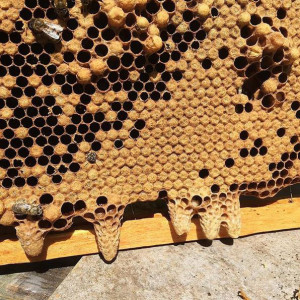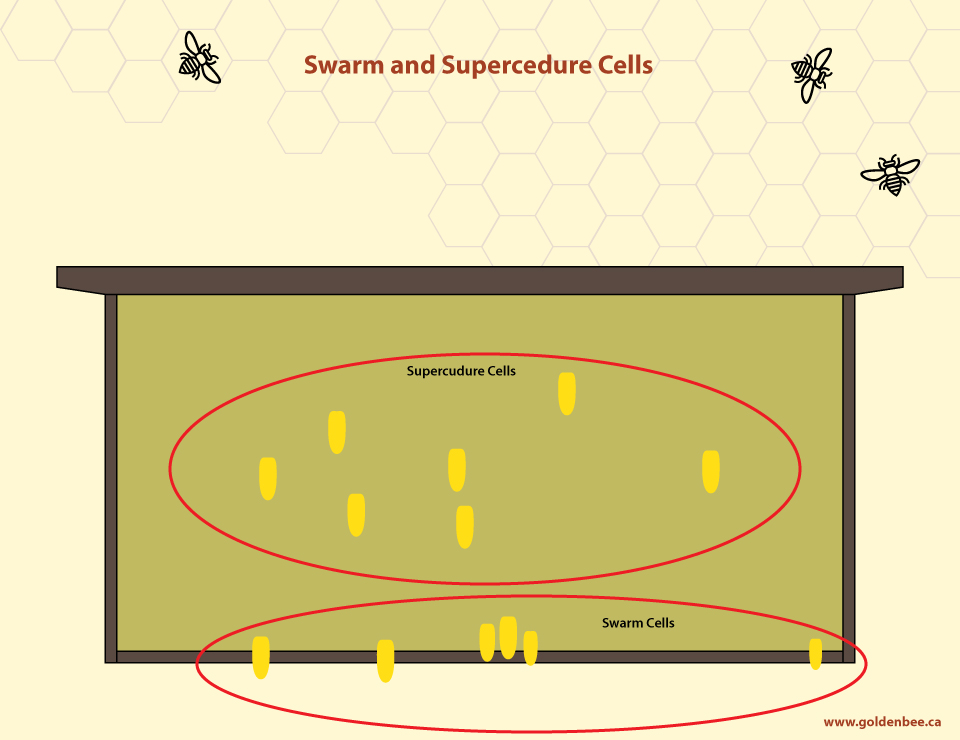Swarm or Supercedure Cells
Background Information

During mid-summer you may often find different kinds of cells in the brood chamber. There is capped worker brood, bumpy drone brood, and you may occasionally come across swarm or supersedure cell. Both swarm and supercedure cells are a natural part of the way things work in a hive. However, the beekeeper needs to understand the difference and how to deal with each type of cell.
Queen cells are oversized structures that are built on the comb. When bees make their own queens via swarm or supercedure, the process is similar but there are a few differences you need to be aware of.
Queen cells differ from other cells in the hive in that they are rough, peanut shaped and hang vertically off the face of the comb. They vary in size and can be anywhere from 1 cm to 2.5 cm in length. They can be found anywhere on the frame and even in hard to see places so it’s easy to miss them especially if they are placed in a corner and are a smaller size.
Queen cells are made when a the bees make a ‘queen cup’ for the queen to lay into. Queen cups look like teacups on the cell. Once the egg is laid, the bees continue to work on the cell like they do when grafting queens. We even use the same terminology ‘queen cups’. or ‘cell cups’ and the intent is the same, its a place to hold the egg.
Swarm or Supercedure

The primary difference used to determine if you have a swarm or supercedure cell is the location. Cells hanging in the middle of the frame are usually supercedure cells while cells hanging on the bottom of the frame are usually swarm cells.
Supercedure Cells
Supercedure cells are meant to naturally replace a failing queen. When bees detect weaker pheromones in an aging queen, or her egg laying rate is reduced, they will replace her via supercedure. The supercedure process begins after the queen lays an egg in a cell and the bees work on developing the new queen cell by feeding royal jelly to the larvae.
Emergency Cells
It’s worth mentioning emergency cells are similar in nature to supercedure. Emergency cells are the same as supercedure but is the term beekeepers use when the queen is accidently killed or gone missing. The bees go into emergency mode and raise their own queen. Since the intent is similar to supercedure (except for killing the queen), emergency cells look similar to supercedure cells.
Swarm Cells
A swarm cell is created with one purpose; to create a second queen. The old queen will leave with half the hive and find a new location. We discuss swarming in greater details here on our swarming page. Swarm cells are found on the bottoms of frames. Most beekeepers will simply prop up the brood chamber and look for swarm cells hanging on the bottom of the frames. Once bees go into swarming mode, it may be difficult to stop them. If you prevent a swarm from happening, recheck in a few days to make sure they aren’t starting new cells again.
Note: The location of the cells is a great for determining the type of cell you have. However, this the location alone will not guarantee type of cell you have. Examine the dynamics/population of the hive to determine what type of cell you have.

Queen Cells: What to do?
When you find queen cells, you need to figure out which type of cell it is. If it’s a supercedure cell, you might want to leave the bees supersede naturally. Bees usually know what they are doing. If you can still find a queen and want to save her, I’d remove her ASAP because there’s a good chance she won’t be around much longer. Marking your queens help detect of you have a new queen present.
If you find swarm cells in development, you probably want to destroy them. Make sure to check every frame thoroughly and get every one. If you miss even one, your hive will swarm. This of course, assumes they haven’t swarmed already. If you find a hatched swarm cell, you are probably too late already.
Save the Queen
When bees make either swarm or supercedure cells, they make more queen cells than they require and they make them on multiple frames. I’ve seen more than 10 swarm cells in strong hives scattered on 4-6 frames. You have plenty of cells and if you leave them intact, the first queen that hatches will kill off all the sister queens. So if you need an extra queen, why not save some of them?
Swarm cells are usually good quality because the hive is strong and has plenty of resources to make well fed queens. That is not the case with supercedure or emergency cells. Those cells are often underfed and will generate subpar queens. If you find ripe swarm cells and need a couple extra queens, you can save them by removing the frames with the best looking cells and place them in a queen mating box or nuc. You can also cut out the cell from the frame but be careful not to damage the cell. I have saved excellent queens this way and an queens on hand is always handy. Remember to destroy all other cells in the hive to prevent swarming.
I never take supercedure or emergency cells. I leave them in the hive and let nature sort it out itself. If two queens hatch at the same time, an epic battle will follow when they meet and the strongest will survive. Sometimes I’ll even destroy all supersedure or emergency cells and add in a mated queen of better quality.